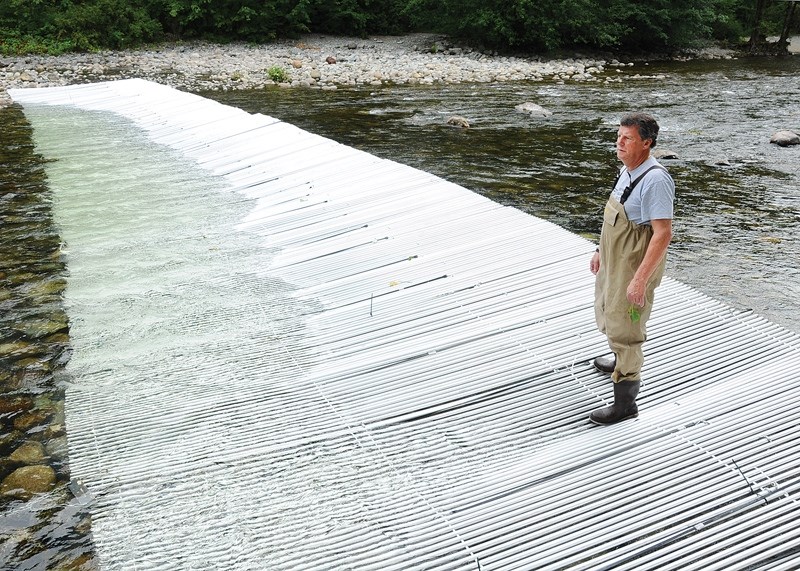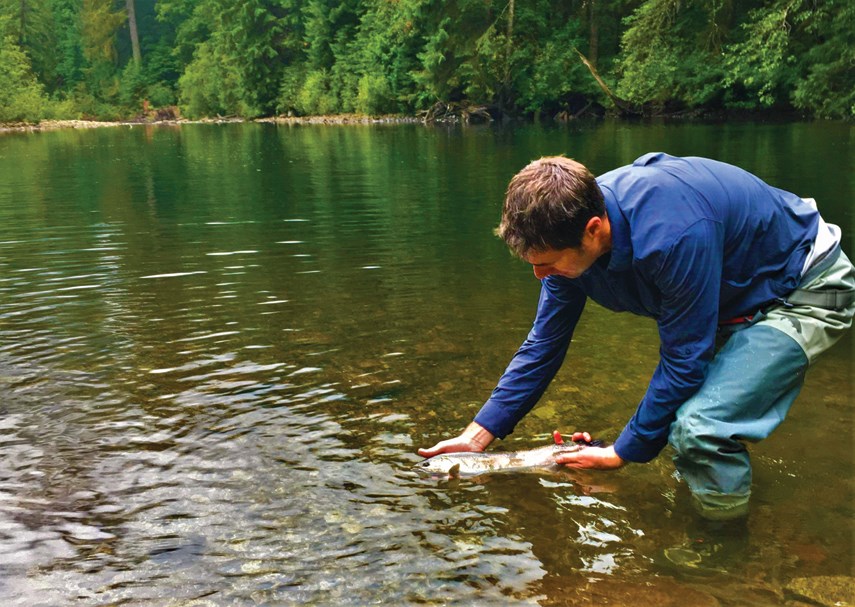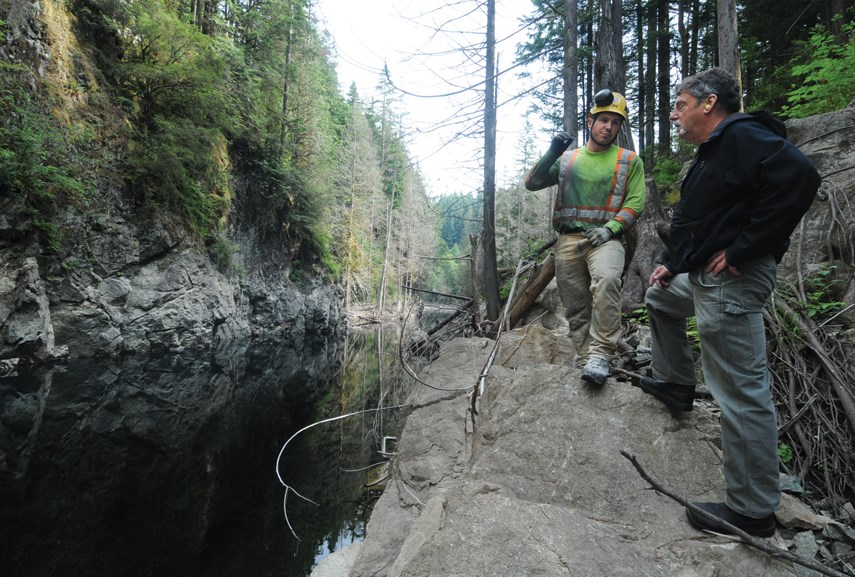It began as a tiny fissure in the rock perhaps 200 years ago.
Over the centuries, water seeped in. It froze and thawed, expanding and putting pressure on the granite, a process known as ice jacking.
Then, around 5 a.m. on Dec. 7, 2014, enough was enough and 80,000 cubic metres of the canyon wall came crashing down, choking the Seymour River to a trickle.
At 9 a.m., a hiker came into the ranger station to report “something was wrong with the river” near the Twin Bridges about two kilometres away.
In the hours following, there was confusion as to what happened. One of the first Metro Vancouver staff members on the scene was Megan Kobitzsch, now the Lower Seymour Conservation Reserve’s operations foreman.
“I stopped at the bridge and got out of my truck and when you stand on the bridge itself, usually it’s about 30 feet down, but the river had come out right up to the bridge deck,” she said. “You can only imagine what I was thinking … I knew we were dealing with some sort of natural disaster.”
In tears and fearing there may be more slides coming closer to the homes on Riverside Drive, Kobitzsch reported what she saw to her supervisors.
Metro Vancouver watershed staff began working 12-hour shifts keeping people off the trailheads and monitoring the hydrometric stations that measure the flow of the river, looking for any fluctuations.
Within six hours of the slide, an 850-metre-long lake formed north of the slide site, 10 metres deep in some parts, and covering two hectares. At the time, Metro staff believed it would be a permanent change in the geography of the North Shore.
Stuck between a rock and a hard place
Shaun Hollingsworth had only just been talked into taking on the role of the Seymour Salmonid Society president. He didn’t hear there’d been a slide until about noon that day – too late to see it in person. In any case, he didn’t think it would pose a problem for salmon.
“I had no idea what it really meant that there had been a rockslide,” he said. “It was late December when I really took to heart what was going on.”
The Seymour River is unique in that it has both summer and winter runs of steelhead trout, as well as summer and fall coho salmon. The federal government has jurisdiction over salmon and the province has jurisdiction over steelhead, so the society first looked to them for a response.
“There was a number of directors that said we should just stand back and wait for the government to do something about this slide. So I started calling senior levels of management within the provincial and federal governments and after several conference calls, it became very apparent – very clear – that neither level of government was prepared to do anything,” Hollingsworth said.
Hollingsworth said he had a gut feel it was the end of the Seymour as a fish-bearing stream. He applied to the Habitat Conservation Trust Foundation for some emergency funds for a study to radio tag juvenile and mature fish. It confirmed what his gut was already telling him. Where water was getting through, it was in six-metre high chimneys or waterfalls.
“There’s no fish that can jump up, or survive that splashdown,” he said.
With no way in and no way out, the Seymour was pretty well dead as a fish-bearing body of water.
That spring, the Outdoor Recreation Council of B.C. named the Seymour one of the most endangered rivers in the province, not just for the fish but for the otters, bears, minks and eagles that feed on them.

Breaking rocks in the hot sun
The Salmonid Society formed a roundtable consisting of six levels of government – the Tsleil-Waututh and Squamish First Nations, the District of North Vancouver, Metro Vancouver, the province and the Department of Fisheries and Oceans – and they agreed to commission a new engineering report laying out options for what could be done about the slide.
Ideas ranged from doing nothing and leaving the site as is, to building a new road into the forest capable of bringing in heavy equipment. Eyebrows were raised at the suggestion, but not hands.
The last option on the table was a plan to use low-velocity explosives to “break the rock and allow Mother Nature to wash it downstream.”
“This was presented to the roundtable and the roundtable accepted it unanimously,” Hollingsworth said.
“There was one small issue, and that was two to five years to execute this plan with a bottom line cost of about $1.25 million,” he said. “Everybody accepted it and left the room and I got thinking, where is the society going to come up with $1.25 million? So at that time, I became very good friends with all the political leaders on the North Shore, looking for funds.”
Gradually, they secured grants from the Pacific Salmon Foundation, the province, the Freshwater Fisheries Society of B.C., the Habitat Conservation Trust Foundation, the Squamish and Tsleil-Waututh Nations, as well as a host of private donors and businesses.
When it came down to the work, they sought out contractors who specialized in high-angle rope work who could safely rappel down to the site, drill holes into the rocks and then plant low-velocity explosives to break them up from the size of city buses or vans into the size of microwave ovens, Hollingsworth said.
The WorkSafeBC paperwork alone was 162 pages long and cost $20,000 to submit.
Work began in the summer of 2016.
While the rest of us cursed the fall and winter rains, Hollingsworth was thirsty for more. In the summertime, the Seymour flows about 1.5 to two cubic metres per second. During a winter storm, it can hit 500 cubic metres per second, enough to take the smaller rocks and wash them down to the canyon floor 200 feet below.
Hollingsworth said he never once had a complaint about the project or the noise it was generating.
Rescue me
But while crews chipped away at the boulders, runs of coho and steelhead still needed to get above the slide site to spawn their next generation.
In the first year, the Salmonid Society called in North Shore Rescue volunteers and firefighters to help trap fish near the mouth of the river and carry them up more than 100 stairs in water-filled backpacks to a waiting truck so the fish could be transported above the slide site or to the Seymour River Hatchery. The society hatched about one million eggs a year there to keep the runs alive.
To increase their efficiency in 2016, the Salmonid Society and Squamish Nation installed a fish fence that would allow the salmon into the river but not out, making it easier for hundreds of volunteers marshalled by the society to net and transfer them.
Hollingsworth struggles to guess how many volunteer hours have been put into the rock-breaking project and the staggering number of people representing different interests who have had a part along the way.
Much like the slide itself, that may have been predestined. During a ceremony to mark the start of the rock breaking in 2016, Squamish Nation council member Chris Lewis said salmon have a storied place in Squamish lore, regarded as a force to bring people together.
“The salmon are a people to us. They come from a great land out in the ocean. There are stories that go back to the origins that remind us of our connection to the salmon people. Those stories say the salmon have the power to bring us all together and they have the power to divide us, so it’s a delicate balance and I’m very proud to be here,” he said. “If the spirit of the rocks did not fall into the river, would we all be here today? Would we all be working together? Or would we all be in our own separate offices doing what we always do, and not talking to one another?”

Troubled bridge over water
While the Salmonid Society worked to mitigate the environmental impacts of the slide, Metro Vancouver had a trail network to worry about.
After water levels reached the bridge deck, engineers concluded, like a bad tooth, it would have to come out, cutting off one of the main crossings over the Seymour River.
Parts of the Twin Bridges, Fisherman’s and Bottletop trails were under water, and thousands of trees flanking the river were dead or dying.
“I would say it’s the most significant event that has occurred in the valley for me and probably the users of the forest,” said Mike Mayers, division manager of watershed operations and protection for Metro Vancouver.
In 2017, Metro sought contractors to design and build a new suspension bridge over the river just south of the Twin Bridge but the only bids that came in were almost double Metro’s budget.
They tried again the next year and awarded a contract to North Vancouver’s Surespan to build a $2-million, 73-metre-long, 2.5-metre-wide suspension bridge. It opened to rave reviews in December 2018.
“Being patient allowed us to do the right planning and it allowed us to get a good product installed that is going to be there for many, many years. If there’s another slide in the canyon, the bridge is up high enough that it won’t be impacted,” Mayers said.
The old Twin Bridge was put in storage for a year before being repurposed. Today it is back in use in the Coquitlam watershed.
Break on through
In August of this year, during the hatchery’s open house weekend, one of the directors stepped out for a walk during a lull in the action. Just below the Seymour Dam, he noticed a flicker of activity near the surface of the water in a pool they would use for catching brood stock.
A volunteer grabbed a rod and fished two coho out. Hollingsworth and other members came to see for themselves, and spotted two steelhead.
They were elated but contained themselves. It was possible someone else caught the fish and moved them up above the slide site. It was time to radio tag more fish to test.
“You can’t go by hearsay or gut feel. You need to prove it,” Hollingsworth said.
Two weeks later, they had their proof when they were able to track a mature coho from below the slide to the top.
“We have been working on this for four years so, for the community, this is just great news. It’s fabulous news. I’m handing out cigars like a new father,” Hollingsworth said at the time.
The water level on the north side of the slide has come down significantly over the years. There’s still a pond at the top, but Mayers said it’s small enough that Metro is unlikely to give it a name.
The engineers, consultants and technicians working on the project had no chance to celebrate before they were seconded to the Big Bar land slide on the Fraser River, a much larger threat to the species on a much larger body of water.
“One of them described it to me as it’s the Seymour on steroids,” Hollingsworth said, adding the Seymour project served as something of a template.
There may be more cleaning up to do at the Seymour slide site in the summer ahead, but for now, the coho and steelhead coming home to spawn will have at least a fighting chance of making it up on their own.
Hollingsworth’s lip immediately begins to quiver when asked what that means.
“It makes me kind of emotional,” he said. “The fact that you can take your children, grandchildren and say, ‘This is what we achieved. This is what we did.’”
Hollingsworth collected some shards of the blasted rock to give to his own grandchildren.




